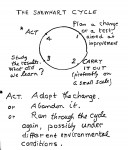PDCA or PPPPDCA?
What does a “culture of problem solvers” really mean? How can teaching PDCA help? or distract?
Some things work, some things don’t. Some things matter, some things don’t. It’s hard to know which is which and chance always has a bigger part than we compute. The real challenge is not just doing things right, but doing the right things:
- Are we solving the right problems (as opposed to being very good at solving well problems that don’t matter)?
- Are we solving them in the right way? Which means with generating the least collateral waste (or are we coming up with solutions that solve the problem but with catastrophic fallout)?
For instance, ERPs seemed to be such a clever solution to optimize the unit cost of each part produced: it optimizes batch use to saturate machines (at some times) and produce a lot of “cheap” parts (from an accountant’s point of view) and to optimize the routing of holding inventories and producing the part in the most efficient way. Smart. As a consequence it disempowers people who no longer understand how the parts are routed through the complex production system, no longer feel responsible for their decisions (hey, I just push the buttons the screen tells me), no longer have an incentive to make production facilities work and a further incentive to solve any constraint with adding production capacity resulting in 1) massive overcapacity of 2) over complex systems, 3) poorly maintained so nothing works and everything needs to be rescheduled constantly. And I haven’t even mentioned data quality.
Could we have known it beforehand? Well, yes. Soviet style central scheduling has never worked so well, and we now have 25 years of lean guys arguing against such ERPs. Does it stop executives from investing in always better, bigger, more totalitarian systems? No, because that feeds their inner need for control (illusory control in this case) and there’s sooo much money at stake in system implementation programs.
Humans love to play with ideas and tools. Our thinking tends to be, “hey, I know what to do, let’s try this and see what happens.” There’s nothing wrong with that, and it gives great results occasionally with very creative thinkers. But with most of us, it gets us to repeat the same old mistakes in a new way – often making the overall situation worse in the process. The trouble is that “hey, what happens if I push this button” can masquerade as PDCA:
- Plan: let’s try this idea, this completely solves our problem
- Do: here’s how we’ll carry it out (are you with me on this, or against me?)
- Check: now we’ve done it, how can we show the results are positive
- Act: I’m sure there are some lessons here, but I have another great idea
Absolutely: better be lucky than good, any day!
Let’s look at what Dr. Deming had in mind:

- Plan: let’s plan a change or a test aimed at improvement
- Do: let’s carry it out on a small scale
- Check: let’s study the results what did we learn?
- Act: Adopt the change, abandon it, run it again in different environmental conditions
You’ve got to know what you want to improve first, then think of one thing you’re going to change.
Which means starting with a clear goal in mind: in order to solve this problem, I NEED TO MOVE THIS PHYSICAL QUANTITY BY SO MUCH – how the Hell do I do that?
Then you “Do” by testing it out, and “Check” by studying very carefully what happens during the test. Is it delivering the hoped for impact. Does it have adverse consequences. And, finally, you draw a conclusion: what did we learn? And so where do we indeed change our thinking and our behavior?
The deeper questions lurking underneath the PDCA are:
- In order to solve this general problem, what are the specific changes we must make?
- As we make these changes, what does it tell us about our understanding of the general problem?
In real life, PDCA feels more like PPPP…DCA. Practicing PDCA means holding off our brains’s natural bias to jump to conclusions, whilst trying quickly many small tests without risks or costs. The point is we don’t want to replace the existing situation by a future one. We want to change it one change at a time.
Which makes us progress on our initial questions: what are the right problems I need to solve? What is the right way to solve them (or the least wrong way)? Now I know:
- What is the one thing I need to try changing today?
- How do I know this change leads me to solve my larger problem?
- Do I still think the larger problem is the right problem to solve?
You start with the quantity you want to see change, by how much, and plan the changes backwards to reach the one thing you need to try changing today. See what impact this had. Then the next. One change at a time.









